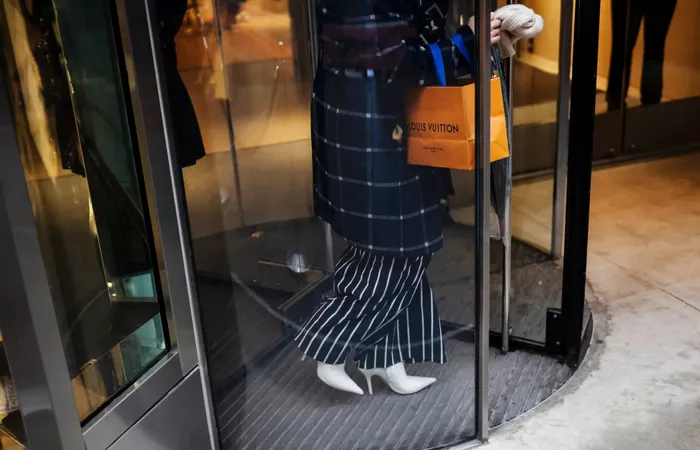A month ago, luxury brands were optimistic about a thriving market with deregulation, lower taxes, and an expected boom in stock prices. However, the introduction of 20 percent tariffs on European Union products by the Trump administration has turned that optimism into concern. Now, luxury businesses are bracing for a future where U.S. consumers might face higher prices on iconic luxury items, such as Chanel’s quilted bags, Rolex watches, and products marked “Made in Italy,” “Made in France,” and “Made in Switzerland.”
The U.S. has been a critical market for luxury goods, with American consumers responsible for 24 percent of the $1.62 trillion spent globally on high-end items, according to Bain & Company. Despite this, the uncertainty brought about by the new tariffs has left brands hesitant to comment on potential price increases or business impacts.
“The U.S. was supposed to be the savior of the luxury goods industry,” said Euan Rellie, co-founder of BDA, an investment bank. “But now, the Trump administration has said, ‘We’re not going to play ball.’ Luxury is in a very tough spot.”
The sector was already facing challenges due to a slowdown in luxury sales in China, a recession in Germany, and an aging Japanese population. The U.S. tariffs add to the uncertainty, and brands like LVMH, Burberry, Chanel, and Gucci have declined to comment on how these new tariffs could affect their products. LVMH, which generates a significant portion of its revenue from the U.S., remains tight-lipped despite the U.S. being responsible for 25 percent of its revenue in 2024.
The tariffs present significant concerns for smaller U.S. luxury brands as well. Doug Hand, a fashion lawyer who represents American brands sourcing materials overseas, said his clients are “biting their nails and pulling their hair out.” Andrew Rosen, an adviser to brands like TWP and Alice & Olivia, expressed frustration, stating, “I don’t even know what the cost of our merchandise will be next week.”
Though large luxury brands like LVMH can absorb some of the costs, analysts predict that the prices of luxury goods will increase if the tariffs remain in place. The uncertainty of U.S. policy under the Trump administration has led many to consider delaying purchases, as Luca Solca, a senior analyst at Bernstein, noted. The situation has created a volatile market, with brands uncertain about future pricing or whether the administration will change course or strike a deal with the E.U.
The possibility of the U.S. manufacturing luxury goods on home soil, one of the stated goals of the tariff policy, appears unlikely. Industry experts, like William Susman of Cascadia Capital, said that none of his clients were considering building luxury apparel factories in the U.S.
Brunello Cucinelli, founder of his namesake brand, dismissed the idea of moving production to the U.S., saying, “Made in Italy is at the core of our identity.” He added that his company would continue to be based in Italy.
The U.S. once produced 98 percent of its clothing in the 1950s and ’60s. However, that figure has since dwindled to just 2 percent, and rebuilding the industry would take years. As such, analysts predict that, if the tariffs remain, American consumers will face significantly higher prices for luxury goods, particularly from European countries like Italy and France.
This situation isn’t just a tax on foreign countries; it’s also a tax on American consumers and companies, according to Rosen. Despite the higher costs, luxury consumers—especially the wealthiest—are expected to continue purchasing high-end goods, as conventional wisdom suggests that luxury items remain resilient even in economic downturns.
However, not all luxury buyers are unaffected by economic pressures. Many affluent consumers, particularly those with shrinking stock portfolios or recession fears, may choose to hold off on discretionary purchases like luxury handbags or jewelry. Achim Berg, founder of the think tank Fashion Sights, noted that about 70 percent of luxury buyers are not ultra-wealthy, and they may be more cautious in their purchasing decisions during times of economic uncertainty.
This climate could also affect the public’s perception of luxury goods. With prices already rising—Chanel bags, for example, have more than doubled in price between 2016 and 2023—many consumers may feel alienated by luxury items that cater predominantly to the super-rich. Claudia D’Arpizio, global head of Bain & Company’s fashion and luxury practice, remarked that luxury brands are facing a “negative perception” and will need to regain consumer trust.
Even amidst a downturn, some sectors of the luxury market may benefit. Sellers of vintage designer goods, for example, could see a surge in demand. Jacek Kozubek, a vintage Rolex dealer, noted that one of his partners flew to the U.S. last week with over 400 watches ahead of the anticipated tariffs.
The emergence of a “gray market” is also a possibility, where consumers could purchase luxury goods abroad and resell them at a profit in the U.S., similar to China’s Daigou system.
As the market adjusts, luxury trends from past recessions may resurface, such as “silent luxury,” where high-end products are purchased discreetly, away from flashy logos and visible brand markings. This subtle approach to luxury could become more appealing to consumers who no longer wish to showcase their wealth in a time of economic uncertainty.
Though the future of luxury handbags and other high-end goods remains uncertain, industry experts agree that the impact of the tariffs could change the way consumers approach luxury purchases for the foreseeable future.
Related Topics
- Amina Shagari Unveils “Blossom” Cruise 2025 at Modest Fashion Week Abu Dhabi
- River Island Launches Vibrant Summer Collection in Collaboration with Del Maar
- Gilles Mendel and Casadei Toast Bridal Shoe Collaboration in Glamorous Carlyle Affair

